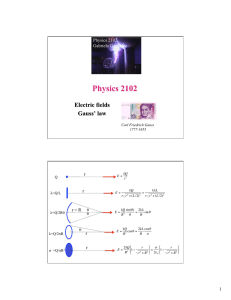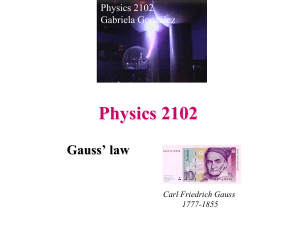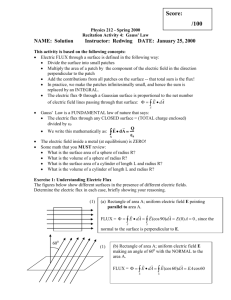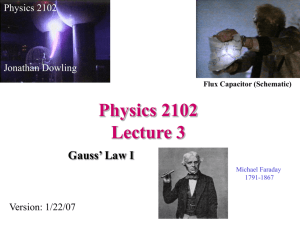pptx - LSU Physics & Astronomy
advertisement
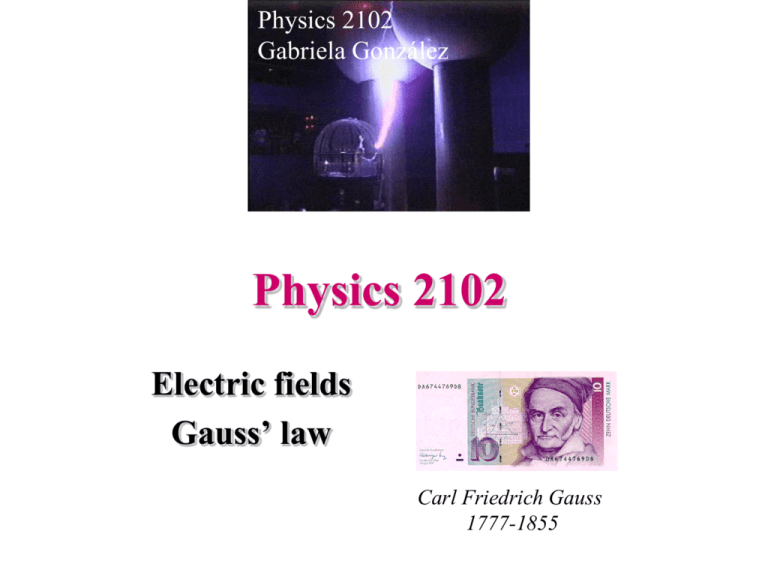
Physics 2102 Gabriela González Physics 2102 Electric fields Gauss’ law Carl Friedrich Gauss 1777-1855 r Q r l=Q/L l=Q/2Rq l=Q/2pR s =Q/pR2 E r=R q q q r r E E kQ r2 kQ r r 2 (L /2) 2 klL r r 2 (L /2) 2 kQ sin( q ) 2kl sin q 2 R q R kQ 2kl cos q E 2 cos q R R p s 2kQ r r E 2 1 2 1 2 2 R r R 2 0 r R 2 Electric field lines and forces We want to calculate electric fields because we want to predict how charges would move in space: we want to know forces. The drawings below represent electric field lines. Draw vectors representing the electric force on an electron and on a proton at the positions shown, disregarding forces between the electron and the proton. e- p+ e- p+ e- p+ e- p+ (d) Imagine the electron-proton pair is held at a distance by a rigid bar (this is a model for a water molecule). Can you predict how the dipole will move? Electric charges and fields We work with two different kinds of problems, easily confused: • Given certain electric charges, we calculate the electric field produced by those charges. Example: we calculated the electric field produced by the two charges in a dipole : • Given an electric field, we calculate the forces applied by this electric field on charges that come into the field. Example: forces on a single charge when immersed in the field of a dipole: (another example: force on a dipole when immersed in a uniform field) Electric Dipole in a Uniform Field • Net force on dipole = 0; center of mass stays where it is. • Net TORQUE t: INTO page. Dipole rotates to line up in direction of E. • | t | = 2(QE)(a/2)(sin q) = (Qa)(E)sinq |p| E sinq = |p x E| • The dipole tends to “align” itself with the field lines. Distance between charges = a +Q Uniform Field E -Q r p Potential energy of a dipole = Work done by the field on the dipole: QE When is the potential energy largest? QE q r E Electric Flux: Planar Surface • Given: – planar surface, area A – uniform field E – E makes angle q with NORMAL to plane • Electric Flux:F = E A cos q • Units: Nm2/C • Visualize: “flow of water” through surface E q normal AREA = A +EA EA Electric Flux F r r E dA • Electric Flux A surface integral! • CLOSED surfaces: – define the vector dA as pointing OUTWARDS – Inward E gives negative F – Outward E gives positive F Electric Flux: Example • Closed cylinder of length L, radius R • Uniform E parallel to cylinder axis • What is the total electric flux through surface of cylinder? • Note that E is NORMAL to both bottom and top cap • E is PARALLEL to curved surface everywhere • So: F = F1+ F2 + F3 pR2E + 0 - pR2E = 0! • Physical interpretation: total “inflow” = total “outflow”! dA 1 2 3 dA dA Electric Flux: Example • • Spherical surface of radius R=1m; E is RADIALLY INWARDS and has EQUAL magnitude of 10 N/C everywhere on surface What is the flux through the spherical surface? (a) (4/3)pR2 E = 13.33p Nm2/C (b) 4pR2 E = 40p Nm2/C (c) 4pR2 E= 40p Nm2/C What could produce such a field? What is the flux if the sphere is not centered on the charge? Gauss’ Law • Consider any ARBITRARY CLOSED surface S -- NOTE: this does NOT have to be a “real” physical object! • The TOTAL ELECTRIC FLUX through S is proportional to the TOTAL CHARGE ENCLOSED! • The results of a complicated integral is a very simple formula: it avoids long calculations! S F Surface q E dA 0 (One of Maxwell’s 4 equations) Gauss’ Law: Example • Infinite plane with uniform charge density s • E is NORMAL to plane • Construct Gaussian box as shown Applying Gauss' law q 0 F, we have, As 0 2 AE s Solving for the electric field, we get E 2 0 Two infinite planes E+=s/20 E-=s/20 +Q Q E=s/0 E=0 E=0 Gauss’ Law: Example Cylindrical symmetry • Charge of 10 C is uniformly spread over a line of length L = 1 m. • Use Gauss’ Law to compute magnitude of E at a perpendicular distance of 1 mm from the center of the line. • Approximate as infinitely long line -- E radiates outwards. • Choose cylindrical surface of radius R, length L co-axial with line of charge. E=? 1m R = 1 mm Gauss’ Law: cylindrical symmetry (cont) • Approximate as infinitely long line -- E radiates outwards. • Choose cylindrical surface of radius R, length L co-axial with line of charge. E=? 1m F | E | A | E | 2pRL lL F 0 0 q lL l l |E| 2k 2p0 RL 2p0 R R R = 1 mm Compare with last class! L/2 L/2 dx x E y kl a 2 2 3 / 2 kl a 2 2 2 ( a x ) a x a L / 2 L / 2 2klL a 4a L 2 if the line is infinitely long (L >> a)… 2klL 2kl Ey 2 a a L 2 Gauss’ Law: Example Spherical symmetry q E dA • Consider a POINT charge q & pretend F that you don’t know Coulomb’s Law Surface • Use Gauss’ Law to compute the electric field at a distance r from the charge r • Use symmetry: q E – draw a spherical surface of radius R centered around the charge q – E has same magnitude anywhere on surface 2 F | E | A | E | 4 p r – E normal to surface F q 0 0 F q / 0 q kq |E| 2 2 2 A 4p r 4p 0 r r Gauss’ Law: Example • A spherical conducting shell has an excess charge of +10 C. • A point charge of 15 C is located at center of the sphere. • Use Gauss’ Law to calculate the charge on inner and outer surface of sphere (a) Inner: +15 C; outer: 0 (b) Inner: 0; outer: +10 C (c) Inner: +15 C; outer: -5 C R2 R1 -15 C Gauss’ Law: Example • Inside a conductor, E = 0 under static equilibrium! Otherwise electrons would keep moving! • Construct a Gaussian surface inside the metal as shown. (Does not have to be spherical!) • Since E = 0 inside the metal, flux through this surface = 0 • Gauss’ Law says total charge enclosed = 0 • Charge on inner surface = +15 C -5 C Since TOTAL charge on shell is +10 C, Charge on outer surface = +10 C 15 C = 5 C! +15C -15C Summary: • Gauss’ law: F = EdA provides a very direct way to compute the electric flux if we know the electric field. • In situations with symmetry, knowing the flux allows us to compute the fields reasonably easily. Electric field of a ring Let’s calculate the field produced by a ring of radius R with total charge +Q, on a point on the axis, at a distance z from the center. A differential ring element will have charge dq, and will produce a field dE with direction as shown in the figure. The magnitude of the field is dE=kdq/r2. Notice that the distance r is the same for all elements! By symmetry, we know the field will point up, so we will only need to integrate the component dEy=dEcosq= (k dq/r2)(z/r)=k(z/r3)dq. Notice that the angle q is the same for all elements, it is not an integration variable! We integrate over the ring to get the magnitude of the total field: E = ∫dEy = ∫k(z/r3)dq= k(z/r3) ∫dq = kQz/r3 = kQz/(R2+z2)3/2 No integral table needed! What’s the field very far from the ring? If z>>R, E~kQz/z3=kQ/z2 : of course, the field of a point charge Q. Electric field of a disk Let’s calculate the field of a disk of radius R with charge Q, at a distance z on the axis above the disk. First, we divide it in infinitesimal “rings”, since we know the field produced by each ring. Each ring has radius r and width dr: we will integrate on r, from 0 to R. The charge per unit surface for the disk is s=Q/(pR2), and the area of the ring is dA=2prdr, so the charge of the ring is dq=sdA=2psrdr. The field of each ring points up, and has magnitude dE = k dq z/(r2+z2)3/2=(1/4p0)(2psrdr) z/(r2+z2)3/2 = (sz/40)(rdr) /(r2+z2)3/2 The total field is then E = (sz/40) ∫(2rdr) /(r2+z2)3/2 = (sz/40) (-2/(r2+z2)1/2 )0R Electric field of a disk If we are very far from the disk, z>>R, E~0: of course, it gets vanishing small with distance. If we use We get E ~ (s/40)(R2/z2) = (Q/pR2)/(40)(R2/z2) =kQ/z2. (Of course!) If the disk is very large (or we are very close), R>>z, and E~s/20 The field produced by any large charged surface is a uniform field, with magnitude s/20.
